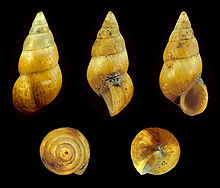Peringia ulvae
| Peringia ulvae | |
|---|---|

| |
| Shell | |
| Scientific classification | |
| Domain: | Eukaryota |
| Kingdom: | Animalia |
| Phylum: | Mollusca |
| Class: | Gastropoda |
| Subclass: | Caenogastropoda |
| Order: | Littorinimorpha |
| Family: | Hydrobiidae |
| Genus: | Peringia |
| Species: | P. ulvae
|
| Binomial name | |
| Peringia ulvae | |
| Synonyms[2][3] | |
|
List
| |
Peringia ulvae, commonly known as the Laver spire shell or mudsnail, is a European
This is arguably a marine snail, but it is often also listed as a non-marine species because it tolerates brackish water and lives in salt marshes and similar habitats.
Peringia ulvae is the type species of the genus Peringia.[4]
Distribution
This species occurs on the coasts of the Baltic Sea, the White Sea[5] the eastern Atlantic Ocean and the western Mediterranean Sea,[3] (the Mediterranean records may be in error) [6] including:
- Great Britain
- Ireland
- The Netherlands
The


Description
This species was originally described by Welsh naturalist
Ulvae.
T. with four spires, the first ventricose; of a deep brown color; aperture oval.
Size of a grain of wheat.
Tab. lxxxvi. fig. 120.
Inhabits Ulva Lactuca on the shores of Flintshire.
"T." is an abbreviated word testa from
The
The width of the shell is 2.5–3 mm.[3] The height of the shell is 4-5.5 mm.[3]
Habitat

Peringia ulvae is a widespread and abundant member of the
Peringia ulvae seems to prefer more exposed localities with less vegetation than the mudsnails
Peringia ulvae feeds on
It is pederictional
One of its natural predators is the Arctic barrel-bubble (Retusa obtusa).[citation needed] In Ireland Peringia ulvae is an important source of food for overwintering waders.
References
This article incorporates public domain text from references[3][1] and CC-BY-2.0 text from the reference[7]
- ^ a b c d e Pennant T. (1777). British zoology. Vol. IV. Crustacea. Mollusca. Testacea. pp. 1-3, iii-viii, 1-10, 1-154, Plates 1-93. London, White. page 132.
- ^ a b Gofas, S. (2010). Hydrobia ulvae (Pennant, 1777). In: Bouchet, P.; Gofas, S.; Rosenberg, G. (2010) World Marine Mollusca database. Accessed through: World Register of Marine Species at http://www.marinespecies.org/aphia.php?p=taxdetails&id=140126 on 2010-11-27.
- ^ a b c d e f g h i j k l m n "Species summary for Peringia ulvae". AnimalBase, last modified 30 March 2009, accessed 16 September 2011.
- ^ "Genus summary for Peringia". AnimalBase, last modified 16 August 2006, accessed 16 September 2011.
- ^ Горбушин А. М. О видовом составе моллюсков рода Hydrobia (Gastropoda, Prosobranchia) в Белом море //Зоол. журн. – 1993. – Т. 71. – №. 9. – С. 47-56.
- ^ Giusti, F., Manganelli, G. & Schembri, P. J. (1995) The non-marine molluscs of the Maltese Islands. Monografie XV, Museo Regionale di Scienze Naturali, Torino
- ^ .
- .
Further reading
- Backeljau T. (1986). Lijst van de recente mariene mollusken van België [List of the recent marine molluscs of Belgium]. Koninklijk Belgisch Instituut voor Natuurwetenschappen: Brussels, Belgium. 106 pp.
- Fish J. D., Fish S. & Foley H. (2000). "The biology of mud snails with particular reference to Hydrobia ulvae". In: British Saltmarshes. Sherwood B. R., Gardiner B. G. & Harris T. (eds.) London, Linnean Society: 165-179.
- Gofas S., Le Renard J., Bouchet P. (2001). Mollusca, in: Costello, M.J. et al. (Ed.) (2001). European register of marine species: a check-list of the marine species in Europe and a bibliography of guides to their identification. Collection Patrimoines Naturels, 50: pp. 180–213.
- Haase M. (1993). "The genetic differentiation in three species of the genus Hydrobia and systematic implications (Caenogastropoda, Hydrobiidae)". Malacologia 35: 389-398.
- Muller Y. (2004). Faune et flore du littoral du Nord, du Pas-de-Calais et de la Belgique: inventaire. [Coastal fauna and flora of the Nord, Pas-de-Calais and Belgium: inventory]. Commission Régionale de Biologie Région Nord Pas-de-Calais: France. 307 pp.
- Горбушин А. М. О видовом составе моллюсков рода Hydrobia (Gastropoda, Prosobranchia) в Белом море //Зоол. журн. – 1993. – Т. 71. – №. 9. – С. 47-56.
External links
- Peringia ulvae at Animalbasetaxonomy,short description, distribution, biology,status
- Peringia ulvae Species account and photograph at Mollusc Ireland.
